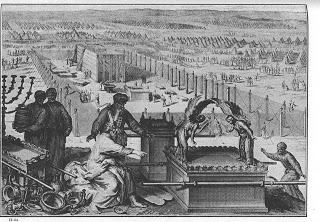 |
| The Erection of the Tabernacle and the Sacred Vessels 1728 |
This week we conclude our reading of the Book of Exodus. The Book of Exodus begins with our enslavement in Egypt, and follows with the story of the Ten Plagues, our leaving Egypt, and our receiving of the Ten Commandments at Mt. Sinai. The final half of the Book of Exodus is devoted almost entirely to the building of the Tabernacle, the portable place of worship in which G-d’s presence will dwell.
We are told that G-d chose two men to oversee the construction of the Tabernacle. Those men were Bezalel from the tribe of Judah and Oholiav from the tribe of Dan. We are further told that G-d endowed them with a divine spirit of wisdom, insight and knowledge.
The careful reader will ask the question: “What is the difference between wisdom, insight, and knowledge? The Biblical commentator Rashi explains it this way: “‘Wisdom’ is that which a person learns from others; ‘insight’ is that which one understands from the heart; and ‘knowledge’ is a gift from God.” In modern terms we might invoke the theory of multiple intelligences to understand this verse. Let me explain. This theory of multiple intelligences challenges the idea that humans are endowed with only one type of intelligence. The theory postulates eight different types of intelligence. In the case of Bezalel and Oholiav, wisdom might be analogous to spatial intelligence, the ability to picture the world in 3D. This would be important in translating the detailed architectural plans for the Tabernacle that G-d gives Moses into reality on the ground. “Insight” might be ‘interpersonal intelligence’, the ability to sense people’s feelings and motivations. This would be essential in harnessing the energies of others to cooperate in building the Tabernacle and its furnishings. “Knowledge” is perhaps synonymous with ‘linguistic intelligence’, the ability to find the right words to describe what one means. This too is an essential intelligence for the task at hand. Commenting on this verse, the medieval Spanish Biblical commentator Ibn Ezra notes that “there are many wise individuals who find it challenging to impart their knowledge effectively to others.” Thus, “linguistic intelligence” or the ability to communicate clearly what one means, would also be an important type of intelligence to possess.
Recall as well that Bezalel is from the tribe of Judah, whereas Oholiav is from the tribe of Dan. The Tribe of Judah is the most prominent of the 12 Tribes of Israel. The Kings of Israel will all come from the Tribe of Judah. The Tribe of Dan is the least distinguished of all the tribes. Whereas the Tribe of Judah marches in the front as the Israelites are traveling through the Wilderness, the Tribe of Dan takes up the rear of the procession through the Sinai Desert. Their job is to pick up everything that the other tribes ahead of them drop by accident!
Therefore it is significant that the two men responsible for overseeing this communal enterprise are from these different social strata in Israel. The tribe of Judah marches at the head of the procession. The Tribe of Dan takes up the rear. This is a model of inclusivity, a symbol of broad participation. In building a community everyone’s voice and talent is welcome and required — the wealthy, the poor, the clergy , the congregants, men, women, LGBTQia+, people of color, the younger, the older, the religious, the atheist….and so forth.
Thus the choice of Bezalel and Oholiav as leaders of the building of the Tabernacle imparts an important message for us. Constructing a space filled with G-d’s Presence requires the range of skills, talents and intelligences that emerge only when we involve the diversity within our Jewish community. Whether in Biblical times or today, building a place for G-d demands the inclusion of everybody and a spiritual embrace of all.
